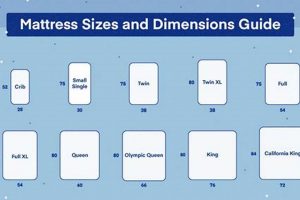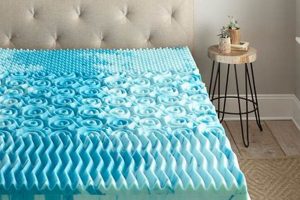A large, rectangular inflatable or foam pad designed for use in tents or other outdoor shelters, providing a sleeping surface comparable in size to a king-size bed. Such a product offers increased space and comfort for one or two individuals during camping excursions.
The expansive dimensions offer increased freedom of movement and better sleep quality when enjoying time outdoors. This results in enhanced relaxation and recovery, essential for multi-day trips or for individuals who prioritize comfort. Early iterations were rudimentary, but modern designs incorporate durable materials and advanced inflation or compression technologies.
The subsequent sections will delve into the various construction types, inflation methods, key features to consider, and maintenance practices associated with selecting the right sleeping solution for outdoor adventures.
Selection and Usage Tips
The following points should be considered when selecting and using a large camping sleep surface to optimize performance and longevity.
Tip 1: Material Durability: Prioritize models constructed from puncture-resistant materials, such as reinforced PVC or high-denier nylon, to withstand rugged outdoor conditions and prevent air leaks.
Tip 2: Inflation Method: Evaluate the convenience and efficiency of different inflation methods. Self-inflating options offer ease of use, while manual or electric pumps provide faster inflation for larger models.
Tip 3: Insulation Value (R-Value): Consider the R-value, which indicates thermal resistance. Higher R-values provide better insulation against cold ground temperatures, crucial for camping in colder climates.
Tip 4: Weight and Packed Size: Assess the weight and packed size relative to carrying capacity. A lighter, more compact model facilitates easier transportation during backpacking or hiking trips.
Tip 5: Storage Considerations: Ensure sufficient storage space is available, as its large size can require a significant amount of room when not in use. Proper deflation and rolling techniques can minimize storage volume.
Tip 6: Compatibility with Tent Size: Before purchasing, confirm that the dimensions are compatible with the intended tent. Sufficient space is needed for comfortable movement around it.
Tip 7: Repair Kit Availability: Verify that a repair kit is included or readily available for purchase. This enables prompt patching of minor punctures or tears, extending the product’s lifespan.
Adhering to these guidelines can aid in selecting a durable, comfortable, and appropriately sized sleeping surface for camping endeavors.
The subsequent section will offer a comprehensive product comparison to aid in making an informed purchasing decision.
1. Sleeping Surface Area
Sleeping surface area, a primary determinant of comfort and usability, is intrinsically linked to the selection and performance of a large format camping sleep surface. This aspect directly dictates the freedom of movement and overall sleep quality experienced while utilizing the product.
- Individual Space Allocation
Adequate individual space prevents overcrowding and minimizes sleep disturbances caused by a partner’s movements. The availability of sufficient area allows each occupant to shift positions without impacting the other, promoting more restful sleep. For example, a standard double mattress provides approximately 27 inches of width per person, whereas a product of this size offers closer to 38 inches, significantly improving comfort.
- Gear Accommodation
The ample surface area provides supplementary space for storing personal items such as clothing, electronics, or reading materials within easy reach. This reduces the need to exit the sleeping area to retrieve items, contributing to a more convenient and organized camping experience. Smaller sleep surfaces often necessitate external storage solutions, which can be cumbersome within a confined tent environment.
- Motion Isolation
Expanded surface area contributes to improved motion isolation, minimizing the transfer of movement between occupants. This is particularly relevant for individuals who are easily awakened by motion. The greater distance between individuals reduces the perception of movement, leading to more uninterrupted sleep cycles. Advanced construction materials can also contribute to motion isolation.
- Thermoregulation
Increased space facilitates better air circulation around the body, potentially mitigating overheating during warmer nights. The ability to spread out and avoid direct contact with a sleeping partner can contribute to improved thermoregulation. Conversely, in colder conditions, additional space may require a higher R-value sleeping bag to compensate for increased heat loss.
These facets demonstrate the critical role sleeping surface area plays in the selection and overall utility of a product of this size. The benefits extend beyond mere comfort, impacting sleep quality, convenience, and even thermal regulation, highlighting the importance of considering this dimension during the purchasing process.
2. Inflation/Deflation Speed
Inflation and deflation speed represents a crucial performance characteristic, impacting convenience and efficiency during camping experiences. These aspects are particularly relevant to large-format sleeping surfaces due to their considerable volume.
- Pump Type Influence
The type of pump employed significantly affects inflation and deflation times. Integrated electric pumps offer rapid inflation with minimal user effort, while manual pumps necessitate physical exertion but provide independence from electrical power. Self-inflating models utilize open-cell foam and valves, offering a compromise between speed and effort, although they typically require topping off with breath or a small pump.
- Valve Design Impact
Valve design is a critical factor in both inflation and deflation processes. Wide-bore valves facilitate rapid airflow, accelerating both processes. Two-way valves prevent air from escaping during inflation, optimizing pump efficiency. Deflation valves that allow for one-way air expulsion simplify the process of compacting for storage.
- Material Flexibility
Material flexibility influences deflation speed. More pliable materials conform easily during rolling or folding, allowing for more efficient air expulsion. Rigid materials can trap air pockets, prolonging the deflation process and potentially increasing packed size.
- Ambient Temperature Effect
Ambient temperature can influence the properties of the materials, impacting th
e process. Cold temperatures can stiffen the material, prolonging both processes, while warmer temperatures can have the opposite effect.
These factors collectively determine the overall user experience related to setting up and breaking down camp. The correlation between pump type, valve design, material flexibility, and environmental conditions highlights the multifaceted nature of inflation/deflation speed in the context of a large-format sleeping surface.
3. Portability and Weight
Portability and weight are critical considerations when evaluating a large format camping sleep surface. These characteristics directly impact transportation logistics and the overall feasibility of incorporating such an item into a camping setup.
- Material Density and Composition
The density of the materials used in construction directly correlates with overall weight. High-density foams or thick PVC fabrics contribute to increased durability and insulation but also result in a heavier product. Conversely, lighter materials, such as thin nylon fabrics, reduce weight but may compromise durability and insulation properties. The choice of materials represents a trade-off between weight, durability, and thermal performance.
- Packed Size and Compression
The packed size of the item, determined by its compressibility and the efficiency of the included compression straps or storage bag, affects portability. Models that compress effectively occupy less volume in a vehicle or backpack, facilitating easier transportation. Inefficient compression can render even a relatively lightweight product cumbersome to transport. Techniques for compacting, such as folding versus rolling, also influence packed size.
- Carrying Method and Ergonomics
The presence of integrated carrying handles or straps influences the ease of transport, particularly over short distances. A well-designed carrying system distributes weight effectively, minimizing strain on the user. The absence of such features necessitates alternative carrying methods, potentially increasing the physical demands of transportation. Ergonomic considerations in the design of carrying straps enhance user comfort.
- Inflation/Deflation Technology
The type of inflation and deflation technology employed indirectly impacts portability and weight. Integrated pumps add weight and complexity, while manual pumps require physical exertion. Self-inflating models eliminate the need for external pumps but may not achieve the same level of firmness as pump-inflated models. The choice of inflation technology should align with the user’s physical capabilities and transportation constraints.
The interplay between material density, packed size, carrying method, and inflation technology highlights the complex relationship between portability and weight. The selection of such a product requires a careful assessment of these factors to ensure compatibility with the intended camping activities and transportation limitations.
4. Durability and Material
Durability and material selection are paramount in the context of a king size camping mattress. The expansive surface area inherently increases the risk of puncture, tearing, or seam failure, rendering material integrity a critical factor for longevity and performance. The materials used directly determine the product’s ability to withstand the rigors of outdoor use, including abrasion from uneven terrain, exposure to UV radiation, and temperature fluctuations. A mattress constructed from inferior materials is prone to premature degradation, leading to air leaks, loss of support, and ultimately, product failure. For example, a PVC mattress exposed to prolonged sunlight may become brittle and crack, while a nylon mattress with poorly reinforced seams may develop leaks under pressure.
Material selection also impacts the product’s resistance to moisture and mildew. Camping environments often involve exposure to damp conditions, either from condensation, rain, or proximity to water sources. Materials with inherent water resistance, such as coated nylon or vinyl, are preferred to prevent moisture absorption, which can lead to mildew growth and subsequent material degradation. Furthermore, the type of adhesive used in seam construction plays a crucial role in preventing delamination, particularly under stress or temperature variations. The use of high-quality, waterproof adhesives ensures that the seams remain intact, even when subjected to repeated inflation and deflation cycles and environmental exposure.
In conclusion, the durability of a king size camping mattress is inextricably linked to the materials employed in its construction. The selection of robust, puncture-resistant, and water-resistant materials, coupled with durable seam construction techniques, is essential for ensuring product longevity and reliable performance in demanding outdoor conditions. A compromised choice in materials inevitably leads to reduced lifespan and diminished user satisfaction. The practical significance of this understanding lies in the ability to make informed purchasing decisions, prioritizing models constructed with superior materials and construction methods, even at a potentially higher initial cost.
5. Insulation Capability
Insulation capability is a critical determinant of a king size camping mattress’s suitability for various environmental conditions. The expansive surface area of such a mattress increases the potential for heat loss to the ground, making effective insulation essential for maintaining thermal comfort during sleep. Without adequate insulation, the user experiences conductive heat loss, resulting in discomfort and potential hypothermia in cold weather. The relationship between surface area and heat loss is directly proportional; a larger surface area necessitates a higher insulation value to mitigate heat transfer.
Several factors influence the insulation capability of a king size camping mattress. The R-value, a measure of thermal resistance, quantifies the material’s ability to impede heat flow. Mattresses with higher R-values provide superior insulation. Construction materials also play a significant role; closed-cell foam offers greater insulation than open-cell foam, and reflective layers can further enhance thermal performance by reducing radiative heat loss. For instance, a king size mattress intended for use in sub-freezing temperatures requires an R-value of 5 or higher, coupled with insulating materials, to prevent significant heat loss. Failure to consider these aspects results in a diminished user experience, regardless of the mattress’s other features.
In summary, insulation capability is an indispensable component of a king size camping mattress, particularly in colder climates. The substantial surface area amplifies the need for effective insulation to prevent heat loss and ensure thermal comfort. Selection should prioritize mattresses with high R-values and insulating materials appropriate for the intended environmental conditions. Ignoring this aspect compromises the mattress’s functionality and can negatively impact the overall camping exp
erience. The challenge lies in balancing insulation with other desirable attributes, such as weight and packability, to achieve a comprehensive solution for outdoor sleeping needs.
Frequently Asked Questions
This section addresses common inquiries regarding large format camping sleep surfaces, providing clarity on selection, usage, and maintenance.
Question 1: What are the minimum tent dimensions required to accommodate a king size camping mattress?
Tent dimensions must exceed the footprint of the chosen mattress. A tent advertised as “family-sized” or with a floor area of at least 8 feet by 8 feet is generally necessary. Confirm internal tent dimensions prior to purchase to prevent fitment issues.
Question 2: Is a separate pump necessary for all king size camping mattresses?
The necessity of a separate pump depends on the specific model. Some integrate electric or manual pumps, while others require an external pump for inflation. Self-inflating models utilize open-cell foam and may require a few breaths to reach desired firmness.
Question 3: How is the R-value of a king size camping mattress related to its suitability for cold-weather camping?
The R-value directly indicates the mattress’s insulation capability. Higher R-values signify greater resistance to heat loss. For camping in temperatures below freezing, an R-value of 5 or higher is recommended to prevent conductive heat loss to the ground.
Question 4: What is the best method for cleaning a king size camping mattress after use?
Cleaning involves wiping the surface with a damp cloth and mild soap. Avoid harsh chemicals or abrasive cleaners. Ensure the mattress is completely dry before storage to prevent mildew growth. Follow manufacturer instructions for specific cleaning recommendations.
Question 5: How should a king size camping mattress be stored to maximize its lifespan?
Storage should occur in a cool, dry place, away from direct sunlight and extreme temperatures. Deflate the mattress completely and roll or fold it according to manufacturer instructions. Store in a breathable bag to allow for air circulation.
Question 6: What is the typical warranty period for a king size camping mattress, and what does it cover?
Warranty periods vary by manufacturer, typically ranging from one to five years. Coverage generally includes defects in materials and workmanship, but may exclude damage from misuse, punctures, or normal wear and tear. Review the warranty terms prior to purchase.
These answers provide essential guidance for understanding and utilizing a large format camping sleep surface effectively. Careful consideration of these factors ensures an optimal camping experience.
The subsequent article section provides a comparative analysis of different models, assisting in informed purchasing decisions.
King Size Camping Mattress
This exploration has highlighted that a king size camping mattress represents a significant investment in outdoor comfort, demanding careful consideration of factors such as material durability, insulation value, inflation method, and packed size. The analysis underscores the importance of aligning these attributes with specific camping needs and environmental conditions to ensure optimal performance and longevity. Furthermore, informed selection minimizes the risk of discomfort or equipment failure during outdoor pursuits.
The pursuit of enhanced outdoor experiences necessitates a comprehensive understanding of available equipment and their respective limitations. As technology advances, future iterations of the king size camping mattress may incorporate lighter, more durable materials and more efficient insulation technologies. Thorough research and careful consideration of individual requirements are crucial for selecting a product that provides lasting comfort and support during outdoor adventures, fostering a deeper appreciation for the natural world.


![Buy Best Mattress Firm King Mattress [Deals Inside!] Organic & Natural Mattress Buyer’s Guide: Non-Toxic Sleep Solutions Buy Best Mattress Firm King Mattress [Deals Inside!] | Organic & Natural Mattress Buyer’s Guide: Non-Toxic Sleep Solutions](https://mattressworldpa.com/wp-content/uploads/2025/07/th-8195-300x200.jpg)




